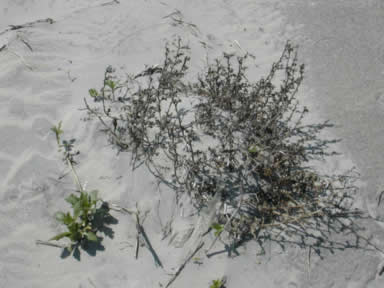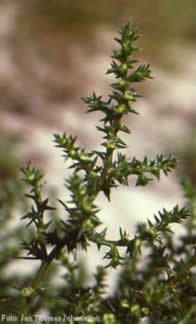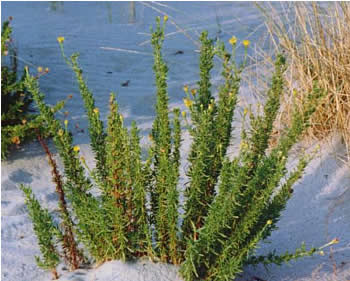Pioneer plants
 |
|
Behind the seashore
belt the first plants, called "pioneer" plants, appear. Their
name comes from their ability to be first in the colonisation of such
a selective environment and in preparing the ground for more exigent plants.
Their work of colonisation is of outmost importance because it allows
the consolidation of the beach and the development of the dunes, thanks
to a series of different vegetal association, each necessary to the development
of the following.
The ecological conditions are difficult in this environment and only some
plants provided with particular characteristics and that have developed
a series of anatomical and physiological answers can adapt to it; actually
this kind of environment allows only few highly specialised species to
live such as: the psammophilous
plants because they live in the sand, the halophytes
as they live in saline environments, xerophilous
plants because they adapt to dry and extremely arid grounds.
The Cakiletum maritimae, which are the plants forming the vegetal
association characteristic of this environment are therophytes,
that is they manage to survive the unfavourable season as seeds. This
belt of pioneer vegetation has halophyle and nitrophyte characteristics.
That means it has a particular ability in bearing at the same time both
the high salinity of the water and the high concentration of nitrogenous
substances. It can be regarded as the "defence line" of the
littoral ecosystem and it is made up of few species with poor vegetative
development but provided with a spread root system able to catch the scanty
nourishment coming from such a dry environment.
The plants that live here have an entangled root system which enables
them to stand upright in such unstable ground; having so well developed
roots they can also reach deep water (from "Un ambiente naturale
unico – Le spiagge e le dune della penisola del Cavallino").
One can find halophile plants that have adapted to salty grounds and can
accumulate the salt in their leaves in order to prevent their cell sap
from having an excessive quantity of it: all that can be verified by tasting
a leaflet of the Russian thistle (Salsola
kali).
The high temperatures of this environment, which are due to insulation,
force these plants to adopt stratagems in order to avoid the excessive
loss of water caused by evapotranspiration: that is the reason why on
these plants we can observe pulpy leaves, covered with thick tuft and
usually whitish in order to reflect sun radiation as much as possible.
One of the first species that can be met is the European sea rocket (Cakile
marittima), which is found just near the border of the
seashore.
It has succulent leaves and stalk in order to endure drought. Its thick
leaves contain a stock of water ( from "Un ambiente naturale unico
– Le spiagge e le dune della penisola del Cavallino"). It has
four small flowers with four white- pinkish petals which bloom for a long
time, from spring to late summer: a strategy to ensure a certain pollination.
If one looks for it very carefully one can also find the not well-visible
Russian thistle (Salsola kali), provided with very small and thorny leaves
in order to avoid as much as possible transpiration.
The Italian cocklebur (Xanthium
italicum), which can be found among the dunes, is a rather
well-visible plant, whose seeds are big and provided with small hooks,
thanks to which the seeds stick to the hair of animals or to clothes,
so achieving an effective seed
dispersal even far from the mother plant. Observing the seedlings
one can easily realise the impressive root development which enables this
plant to reach deep water.
The Italian cocklebur represents the first barrier against which the sand
blown by the wind tends to accumulate, but it cannot form stable dunes
because it acts as an effective barrier only during the vegetative period.
After seeing the characteristics of this belt of vegetation it is possible
to claim that the Cakil etum, even if it is constantly present in this
environment, cannot be defined as a proper vegetal restoring association,
because it does not actively contribute to the development and to the
coming of new species.
This function is delegated to another plant the sand couch (Agropyron
junceum) which, together with the golden samphire (Inula
crithmoides), is the only one to be able to penetrate
the Cakiletum.
The sand couch is a graminacea particularly effective in the stabilisation
of the sand thanks to its long roots, with which it can enrich the beach
with organic
matter, fhelping the following settling of other species (from.
"Un ambiente naturale unico - Le spiagge e le dune della penisola
del Cavallino).
The golden samphire on the contrary is a perennial plant (hemicryptophyte)
with fleshy leaves, typical of saltmarsh environment.
The sand couch presents two adaptations ensuring an easy propagation:
- dissemination: the rachilla that bears the spikelets during
summer breaks in small fragments, each of them bearing very light spikelets,
which are transported by the wind very far away from the mother plant.
This system of dissemination is unusual for this species, but it is frequent
in other species of agropyron;
- stolons: the sand couch has long stolons,
either underground or creeping on the surface of the sand, which allow
the plant to spread by vegetative way.
|



